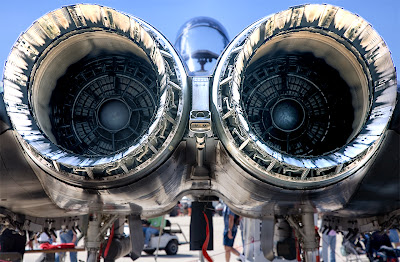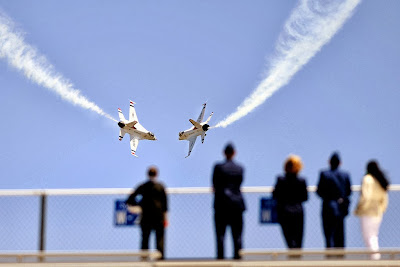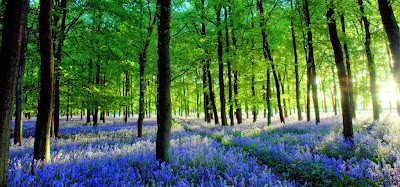Guest Post by: Captain Suresh Sharma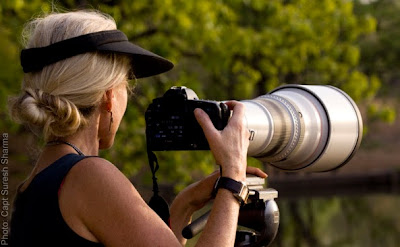 |
| Wildlife Photographer |
WILDLIFE PHOTOGRAPHY is certainly that stream of photography which has no match for the excitement, thrill and action it renders to one’s heart and sense of satisfaction for one’s soul ! And wildlife photographers are ambassadors of `nature conservation’, play a major role as a crucial link between research and common man. Probably, these are the broad reasons wildlife photography entices almost everyone, even the ones who just hang one camera around their neck. And with the advent of digital cameras, the clan has grown multi-folds in last few years and growing by the day. Almost every photographer’s dream is to do wildlife photography, even if one’s primary profession is other branches of photography or a completely different profession. Why not? For it has glamour of its own! It surely has steep challenges, which many people love negotiating in real life and that is why it has earned that a tag of `niche glamour’. Wildlife photography is like wooing a beautiful woman! Not all will be lucky to get her, in spite of the best chase. Not everyone’s cup of tea..in nut-shell.
There are many factors. One more reason for every man to love wildlife photography – instinctively just like every man worth his salt chases the most beautiful woman, same hormones drive every man equipped with camera and photography skill to test his luck chasing animal world. And a strong instinctive desire to live closer to nature and the spirit to explore life around has always coaxed man to record the natural history wonders, now with cameras. Some use it as a means of recording the nature and its phenomenons and some create soul-stirring art with it and some lucky ones make their living. Wildlife photography earns ardent admirers for those who perform and achieve. Also, nature has always wheedled most of us into its lap, where it has many wonders to unfold to those who care and dare to explore. This breed of photographers unfold the sensational mysteries of natural history as well. In fact wildlife photographers are ambassadors of wildlife conservation in true sense. Its the concoction of various instincts, desires, skills, hormones, etc. that makes most photographers drone all the time around wildlife photography.
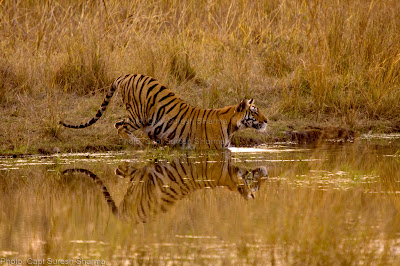 |
| Tiger is homing on to its pray, which is across water stream. |
My purpose of writing here is to erode the illusions of most young budding photographers about wildlife photography. I keep getting requests and variety of questions about wildlife photography and related issues everyday. Most do not realize what makes a good wildlife photographer, how to go about it. The first and foremost thing is one has to assess one’s own potential first or develop i.e. one has to have easy access to wildlife, develop some natural history knowledge, minimum average physical fitness, not to mention suitable camera equipment (what one has and what one will need), financial strength to bear with its tall demands, etc. In spite of all this, all are not so lucky to make good wildlife photographs. Many get stuck with the compulsions of life (job and family), many can not decide which way to go and most are slaves of personal habits i.e. poor discipline, mixing it with pleasure, sleep, attitude, etc. I also feel many get fascinated by these long lenses, the fan club which wildlife photographers enjoy on internet forums, and it has macho tag for many.
And then one can say some are born lucky who have eye of a good artist and have good discipline, are in the habit of getting up early, the ones who don’t love anything other than wildlife photography, focused. Above all, fortunate to have enough money to support this expensive hobby. So, that is how one makes few steps forward to one’s own niche, as one moves up one gets admirers too. Who won’t like it?
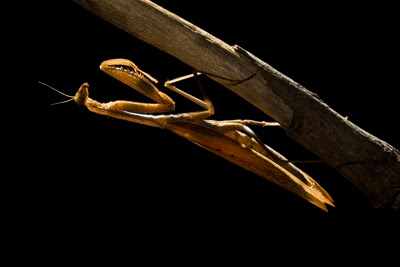 |
| Praying Mantis |
Also, we need to come out of another self-spun illusion that wildlife photography is all about tigers, elephants, rhinos and leopards. Most of us, at infancy stage, think that the treasure trove of wildlife photographs is only inside national parks and wildlife sanctuaries. Though, I do not deny this fact that most of the wildlife today is in protected areas and thus flourishes only inside these heavens. The beauty and mysterious life the smaller creatures have is amazing and makes them a much better subject in my views. There is another perspective to it, viewers love to see what they haven’t seen or do not get to see as a routine in life. So, one can shoot smaller animals like insects in one’s backyard, nearest public garden, agricultural fields, bushes, road side trees, etc. It costs no money, no big effort of packing and driving to national parks, only needs inexpensive equipment (one camera body, macro lens, a tripod), to shoot beetles, butterflies, moths, praying mantis, etc. Other than this – one just needs plenty of time and patience! Not to forget some cookies and a water-bottle, on a bicycle.
 |
| Python |
If you are looking at the bigger game for serious photography, then first of all, muster good money to buy you a good set of camera equipment i.e. two camera bodies with high speed of `fps’ and higher mega pixels, professional lenses which are in the range of US$ 10,000 each, the best tripods (legs only will cost US$ 1000 or more) ball heads (US$ 1000 or more), not to mention numerous expensive accessories one needs all the time. Next comes, expensive traveling which may be by air, train or road to reach (long distances) the well protected wildlife areas which have good wildlife to photograph and worth your camera. One needs advance bookings to check into a good lodge on arrival, which is safe for your equipment and looks after you well to ensure your comfort (you need that after day’s hard work), costing Rs 2500 and above per day. While you start unpacking your camera boxes, someone has to check the condition of your vehicle for the jungle safari, which will cost you Rs 2000 per day (must have gone up much more by now). If you are serious about wildlife photography and have suitable camera gear, then I would strongly suggest that there should be only one person in one vehicle, with one well trained assistant, at the maximum. O, I forgot to mention the entry fees for the vehicle, photographer, assistant, driver, camera equipment (this can vary park to park), hiring of a guide for each trip, etc. All this adds up to minimum Rs 5000 plus to do wildlife photography per day in any Indian national parks and sanctuaries, including the cost of your stay in a lodge. Not to forget all the `red-tape’ and petty skirmishes of the park staff and locals, you will face in this field, most of you may not even notice everything, but it happens. Then you may face some unpleasantness at the gate, just at the start of your safari and then those noisy unruly tourists from Delhi, for home its just like another circus.
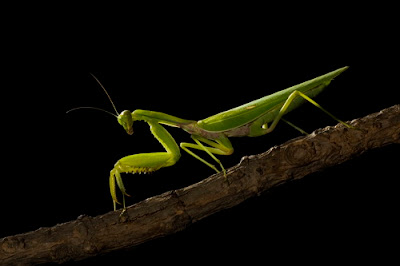 |
| Praying Mantis |
If you really wish to do serious wildlife photography then you should be able to pull some `powerful strings’ for special entry and then everything works very well and like a well oiled gearbox … no noises. There shall be no restrictions on your entry, no limit on timings, areas or zones you will be allowed to explore, get the forest department guides to lead you, etc. I am writing this out of own my personal experience. But that doesn’t mean that one can not do good photography without these `strings’. But when photographers from BBC and Nat Geo want to do photography they pull the best strings and get those results which set new standards in the field.
I am sure, you all will ask one question that if wildlife photography is so tough and the rewards are so meager and that too not many are lucky, then why there are still some wildlife photographers who invest so much of money and efforts for this. You must see what all has gone into making them as big wildlife photographers of name and fame, why they buy that equipment, try to take a peek at the hidden things `behind curtains’. Some of these few are lucky to have their well paying businesses, jobs and having time too, some have been lucky to be around wildlife areas, some own lodges, some are paid to become a lucky one. Nothing has come into being overnight and so easily as you all think, they all have worked very hard to their way up the ladder.
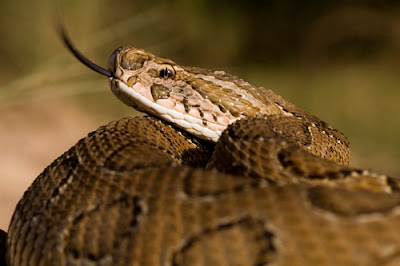 |
| Russels Viper |
REMEMBER : Ideally, one should pursue that activity first which is within one’s reach easily, which means select a subject that is not far from your base (this way you cut cost on logistics, travel and no leave required from your job), your basic equipment can deliver good photos, etc. First brush up the basics of photography this way and reach a level when you do not make basic mistakes. One should be able to handle any tricky exposure situation in the field; I have seen people whispering about what settings I should use. If one is doing so, there is no bigger fool than the one who is paying to grope in darkness like a blind man. Everyone, makes mistakes and a humble start with basic equipment and makes one’s way up as per one’s own capabilities, efforts, patience and perseverance. Nothing comes free in this world !
Some are lucky to be working in the jungle lodges and resorts around national parks and wildlife areas, that means easy access to wildlife areas as a paid naturalist and most costs are reduced this way. Others have moved ahead like a turtle slowly and steadily, through the standard grind of this passion/ profession. They all have toiled very hard patiently to reach where you see them shining like a star or sun. Not realizing what made them shine, we keep trying to emulate them aimlessly. One of the important things, one must have some basic knowledge of natural history, most important assets one needs to have, to make a significant dent in this field. Otherwise, you shall remain one of the insignificant ones in the crowd.
 |
| Caterpillar |
Now, if you are a basic photographer like me (with limited resources), then turn around and peep into your backyard, balconies, city gardens, bushes, agricultural fields, there is plenty of wildlife, i.e. birds, insects, lizards, butterflies, vegetation, etc. Let me remind you, this way, you will need equipment which will cost you only one twentieth of that which is mentioned above, even if you buy pro equipment (professional macro lens, 300mm lens with 2X, suitable tripod with ballhead, a flash, two camera bodies, etc.). If you are worth your salt, and everyone can not be, you will crawl up and the speed will commensurate to the size of your sincere efforts only. At the end of the day, I mean at some point of time, we all love to be rewarded which could be in terms of money (to support your expensive equipment and on-going upgradation all the time), publications for name, stock photos for sales, etc. In case of wildlife photography, I find that the sale is too less when we compare it to other branches of photography i.e. life style, travel, fashion, etc. BEWARE :: SUPPLY IS MORE THAN DEMAND !
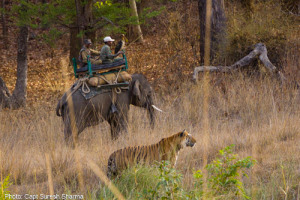 |
| Tiger Show at Bandhavgarh |
My aim here is NOT to discourage you, its to throw some light on the path which most of you wish to tread in the years to come and you seek some guidance from the ones who have been there. You need an external support to sustain, if you wish to start working as wildlife photographer right from the beginning and nothing else.There are numerous examples, whose `first love’ is wildlife photography, but are fashion photographers which is so paying that it can buy them good equipment and can afford access to wildlife areas and can afford to take time off their primary profession. They do get rewarded well, as they have all that which helps them to get good wildlife photos.
Life is too short to do experiments, but some love experimenting like me. But then I am very clear what I want in life, happiness, not by achieving big goals, but by doing what I like doing the most. I drifted into travel photography, as its so easy, take one wide angle lens and walk in the streets or a fair or cultural event, go around a monument, etc. and shoot to your fill. I do nature photography which you can see as cactus photography, flower photography, snake photography, insects, etc. on my website and blogs.
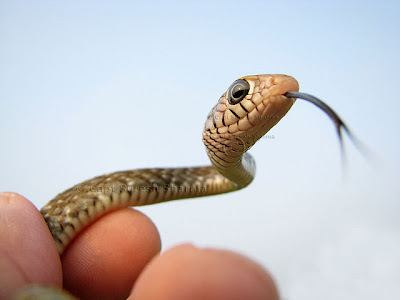 |
| Snake Photography |
Do you know one can do wildlife photography with wide angle lens as well? That means there is no specified camera gear for wildlife photography. But at the same time I pity the rookies with designer hats on head with no gray matter to reckon with (it seems) and cocky tails up skywards, scuttling around like headless chickens, zipping around the national parks having SLRS with 70-200 mm lenses, pushing and flogging their drivers and guides to get them a tiger yawning on the road and into their camera straight and nothing less. Trying to decipher the code of the `hidden world of nature’ with no knowledge at all, even the crackling noise of each dry leaf probably having a beetle underneath croaking for its mate, as if there is tiger around and these rookies raise their their tails up. Every scream of any four footed is an alarm call for a tiger, guides and drivers of their safari vehicle giggle behind the woolen scarfs. It takes them just a wink of an eye to wean out `grain from husk’ and their effort to get you a tiger depends on where you stand in their list of photographers who are rated as worth their salt.
 |
| Tiger Spotted |
You must hear the gossip and the expert comments on these whooshing jungle safari vehicles by these `expert wildlife photographers’, fake spirits are sky high and if there is adrenalin in the world then its only their veins with plenty, leaving the world dry by even a drop of it. But then what happens to these `experts’ – I see them gasping in Delhi (read cities) and having not even one single shot for years which fills their soul and makes their friends envy them. Alas, if they had woken at some point, they would have enjoyed the `symphony of the nature’ at least, which is at its best in the jungle. Neither they recorded (for want of gray matter and gear, which could make them see the right path to follow), nor they witnessed or enjoyed it.
My sincere advice here is that do not fool yourself, make an assessment and see what you can do under the given circumstances and how to move ahead. Best is to work with a seasoned wildlife photographer, as an apprentice and take a closer peek at this charming hobby/ passion. Do not move around like a headless chicken. Otherwise, you will face harsh reality after being a looser. Enjoy photography and do it for your soul and not to capture everything on this earth for competitions and exhibitions. If you are clear about why you wish to do it, you must. Nothing can stop a willing mind. Do not pursue wildlife photography just for its macho!
One must know what your present equipment can deliver and what it can’t, exploit that fully, first.
Before you jump on to expensive wildlife photography workshops and tours/ safaris, prepare yourself as a photographer. And then next promotion should be as a wildlife photographer.
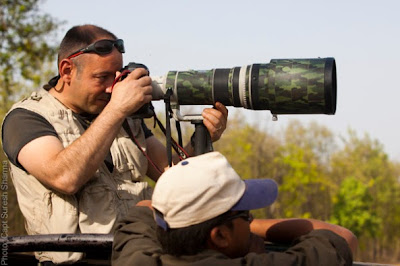 |
| Wildlife Photographer |
DO NOT JUMP THE GUN … And do not ape others …First, grind your photography skills and tame the camera!!!
Captain Suresh Sharma is one of the leading wildlife photographers in India. He also runs one of a kind photo tours and expeditions under the banner
Green Dot Expeditions, Connect with him via
Facebook or Visit his amazing
Photostream on Flickr.
Related Reading





